ITNE2003 Lab Tutorial 4
{`ITNE2003
Install, Configure, Operate and Troubleshoot Medium-Sized Networks
Lab Tutorial – 4 of Lesson - 4
Victorian Institute of technology
`}
Task Assignment
- Design address plan for the given network. IP network to be subnetted is 172.16.128.0 with mask 255.255.128.0
- Then implement the network diagram using Packet Tracer with your IP addressing plan.
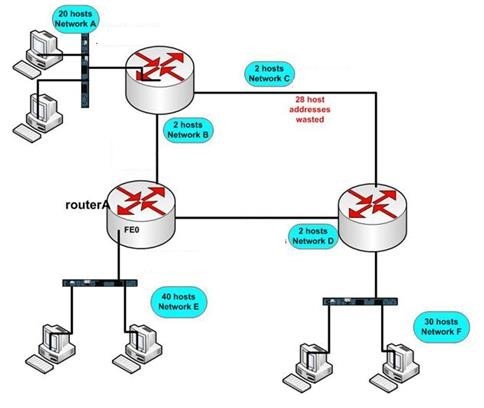
1. Network Address Plan
We can divide our given address block to smaller subnets in two ways: 1) we can create subnets with minimum number of wasted IP addresses. 2) Use the whole address block to divide our network to smaller subnets and don't care about IP addresses that are wasted in each subnet.
In our scenario we use the first option to reduce the number of wasted IP addresses. However, below you can find the table representing subnetted network via second option.
- Classful with minimum waste:
The biggest number of IP addresses that we need in one subnet is 40, so we have to do the subneting calculations based on that. In this case we can minimum the number of wasted Ip addresses while doing IP classful subnetting.
For securing 40 ip addresses per subnet, we have to use 255.255.192.0 or (/26) subnet mask which gives us 62 valid addresses.
|
No. Of Hosts |
Network Address |
BroadCast Address |
Net Mask |
|
40 |
172.16.128.0 |
172.16.128.63 |
255.255.255.192 (/26) |
|
30 |
172.16.128.64 |
172.16.128.127 |
255.255.255.192 (/26) |
|
20 |
172.16.128.128 |
172.16.128.191 |
255.255.255.192 (/26) |
|
2 |
172.16.128.192 |
172.16.128.254 |
255.255.255.192 (/26) |
|
2 |
172.16.129.0 |
172.16.129.63 |
255.255.255.192 (/26) |
|
2 |
172.16.129.64 |
172.16.129.127 |
255.255.255.192 (/26) |
- Classful using the whole subnet:
The number of required subnets is 6. As we already know we can only devide our address block to 2,4,8,16… subnets. So the closest number of subnets to it is 8 subnets. The following table shows how we can devide oue address into 8 subnets:
|
No. Of Hosts |
Network Address |
BroadCast Address |
Net Mask |
|
40 |
172.16.128.0 |
172.16.143.255 |
255.255.240.0 (/20) |
|
30 |
172.16.144.0 |
172.16.159.255 |
255.255.240.0 (/20) |
|
20 |
172.16.160.0 |
172.16.175.255 |
255.255.240.0 (/20) |
|
2 |
172.16.176.0 |
172.16.191.255 |
255.255.240.0 (/20) |
|
2 |
172.16.192.0 |
172.16.207.255 |
255.255.240.0 (/20) |
|
2 |
172.16.208.0 |
172.16.223.255 |
255.255.240.0 (/20) |
|
0 |
172.16.224.0 |
172.16.239.255 |
255.255.240.0 (/20) |
|
0 |
172.16.240.0 |
172.16.255.255 |
255.255.240.0 (/20) |
2. Network Topology
Before we start to configure the above network, we need to create the topology in our Packet Tracer simulation tool.
First, lets add our routers to topology area. In this example we have used Cisco 2811 model.
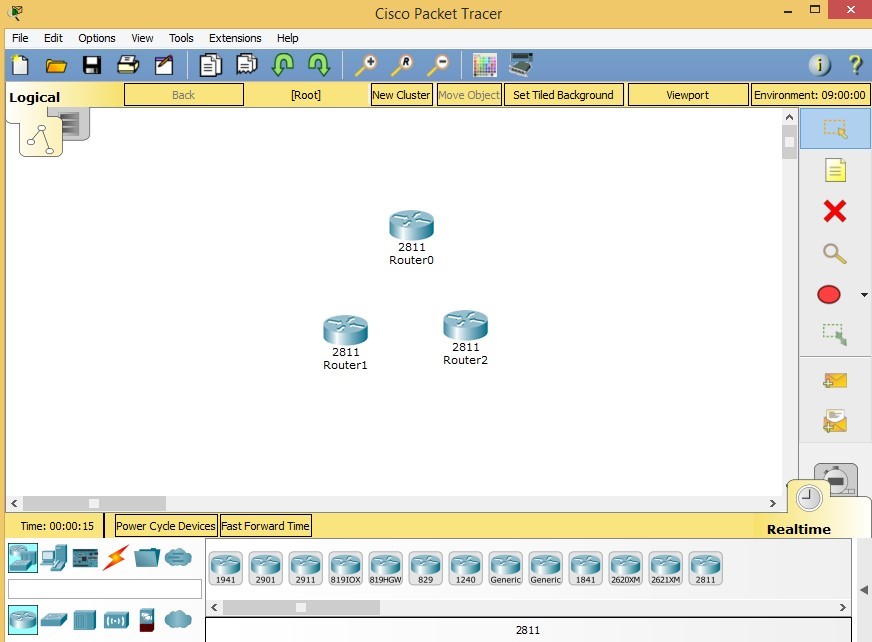
Now if you click on a router, a window will pop up which shows the physical statsus of the router. As the following figure shows, the device is “On” and there is no interface card added to it.
1. Add interfaces
In order to connect routers to eachother witch “Serial” cables, we need to add an appropriate module with serial interfaces on it.
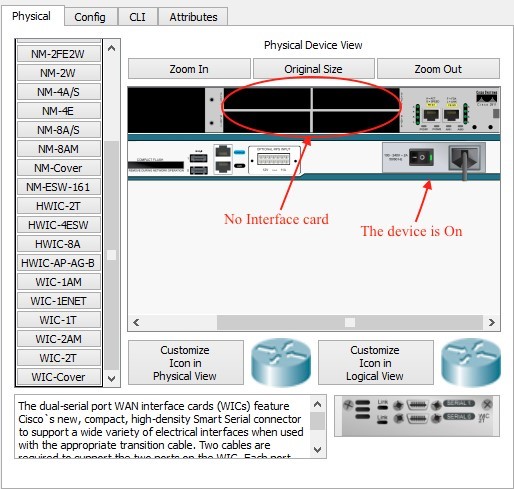
In order to add modules to router, the router should be switched off. So, by clicking on the button you can switch off the device.
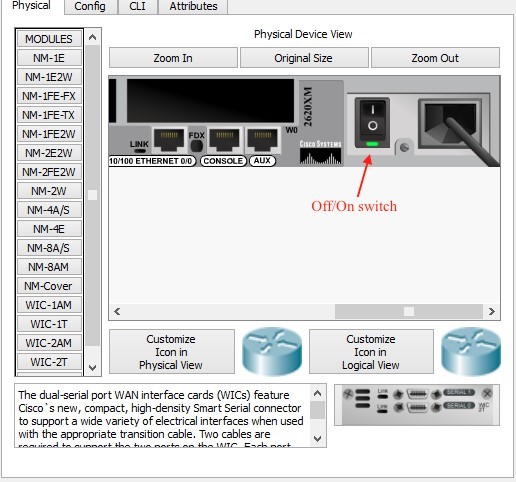
One of the modules that can be used here is “WIC-2T” which has 2 serial interfaces. You can drag this module and drop into one of the four available slots on router.
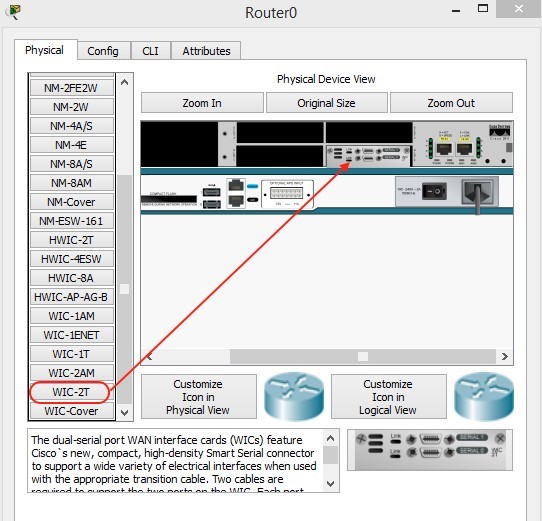
Remember to switch on the router after you added the module.
After adding serial interface to routers, we can use serial cables to connect routers to eachother. 2. Add connections

You can choose between two types of serial cables (DCE and DTE). Between two connected routers one should be DCE and the other would be DTE. DCE router is responsible for clocking. If you select DCE cable, the first router you are connecting the cable would be the DCE router and the other end DTE.
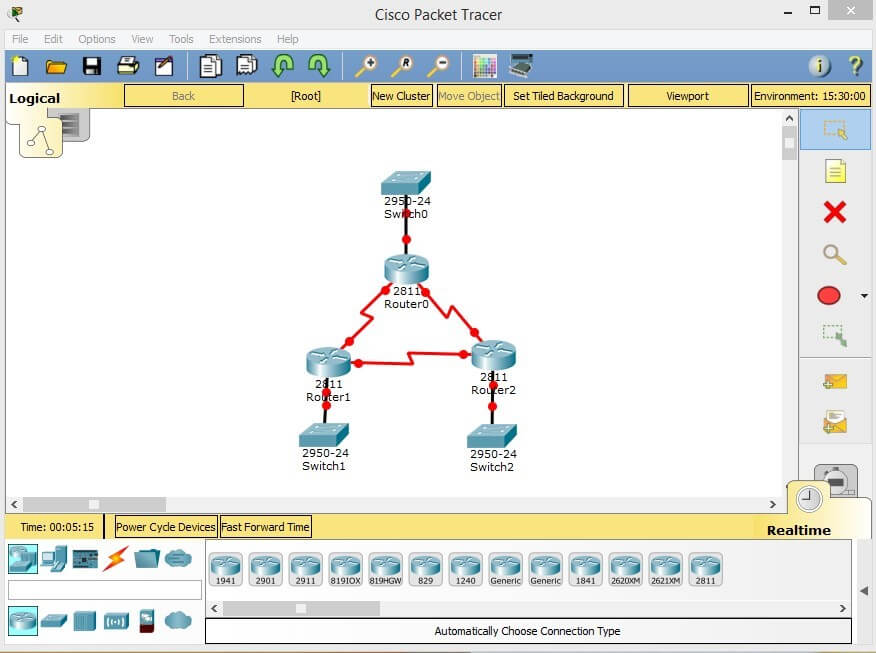
After connecting routers and switches, we add multiple PCs to make our topology more realistic. Also we add information about subnets to have an overview of IP addresses to be used in our network.
Following figure shows the complete topology of our network.
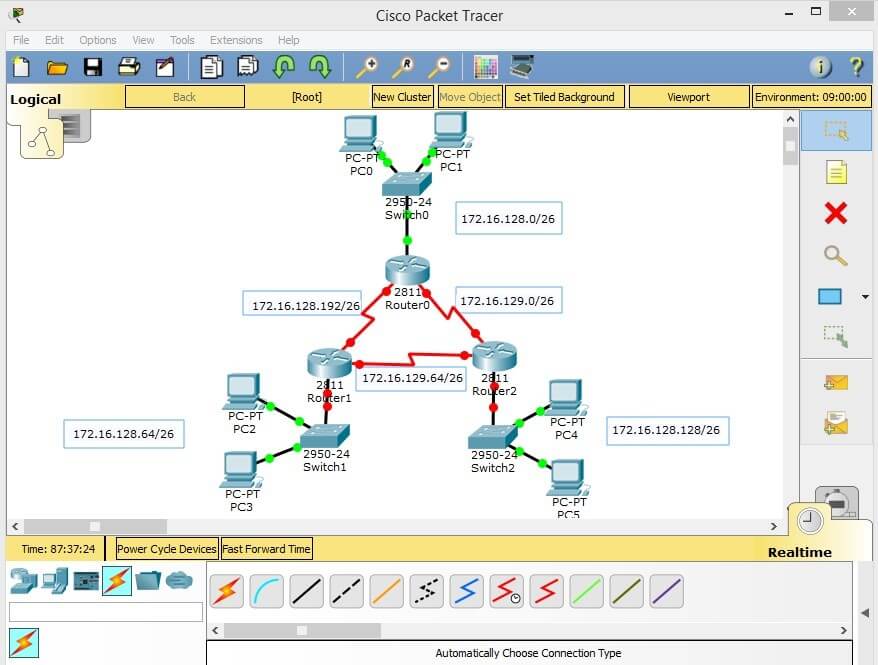
3. Configuration 1. Accessing CLI
After you clicked on a router, go to “CLI” tab and you can access the command line interface of router.
Answer “NO” to “ Continue with configuration dialog?” in order to configure the router manually.
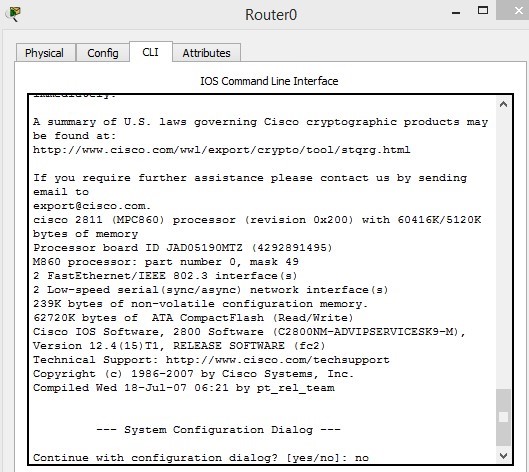
2. Hostname
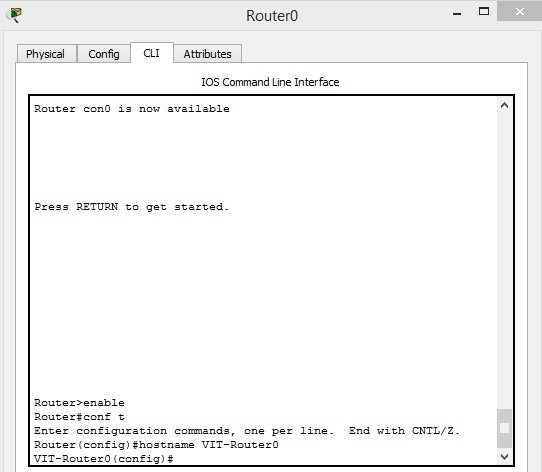
- Interface configuration
1. Show interface
Using show interface command, you can check the status of router’s interfaces. Since no configuration has been applied on router, interfaces are down. Following figure shows the status of Fastethernet 0/0.
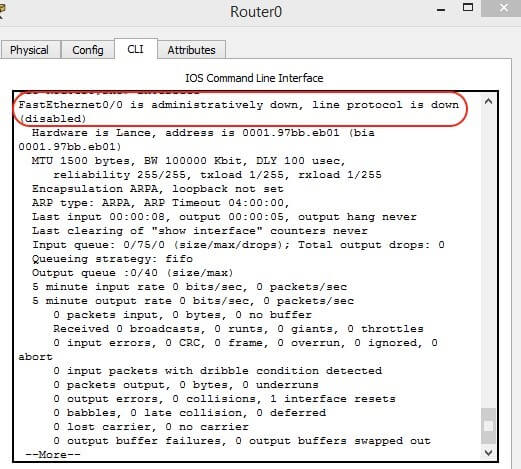
Following figures show configuration needed to bring the interface up.
2. FastEthernet 0/0
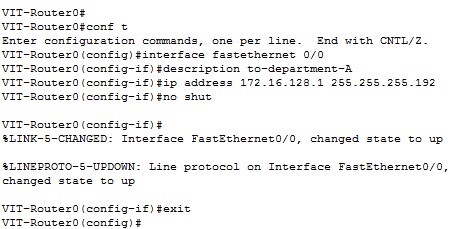
3. Show Controller
As mentioned above, router’s interface is either DCE or DTE. By issueing “Show Controller” command, you can figure out if the interface is DCE or DTE. Knowing this information is important, because for DCE interfaces additional command is needed to set the clock rate. Otherwise the connection wouldn’t be up and running.
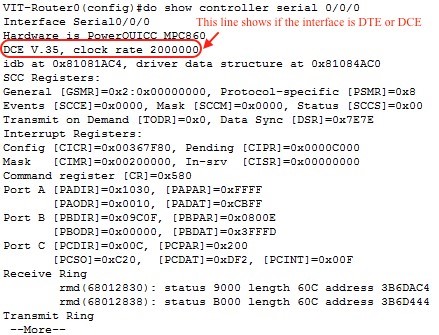
4. Serial 0/0/0
Below, the configuration of serial interface 0/0/0 is shown. Remember that if the clock rate has not been set on DCE interface, you have to configure it using “Clock Rate” command.
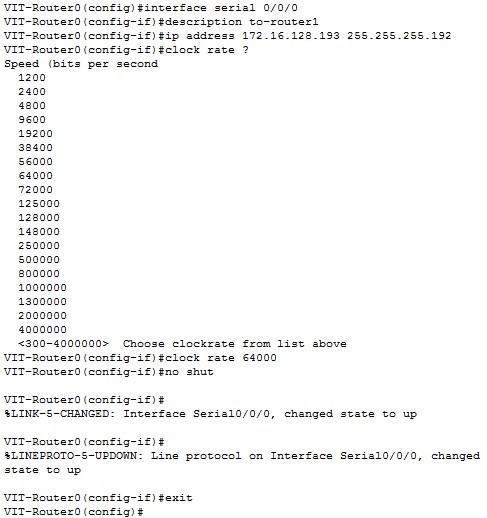
4. Save the running configurations
Finally, we save the running configuration to NVRAM so the router can load the configuration automatically next time when power on.
After assigning IP addresses to all three routers according to your address plan, all the links would come up and be finctional. Green dots on routers interfaces show that links are up and running.
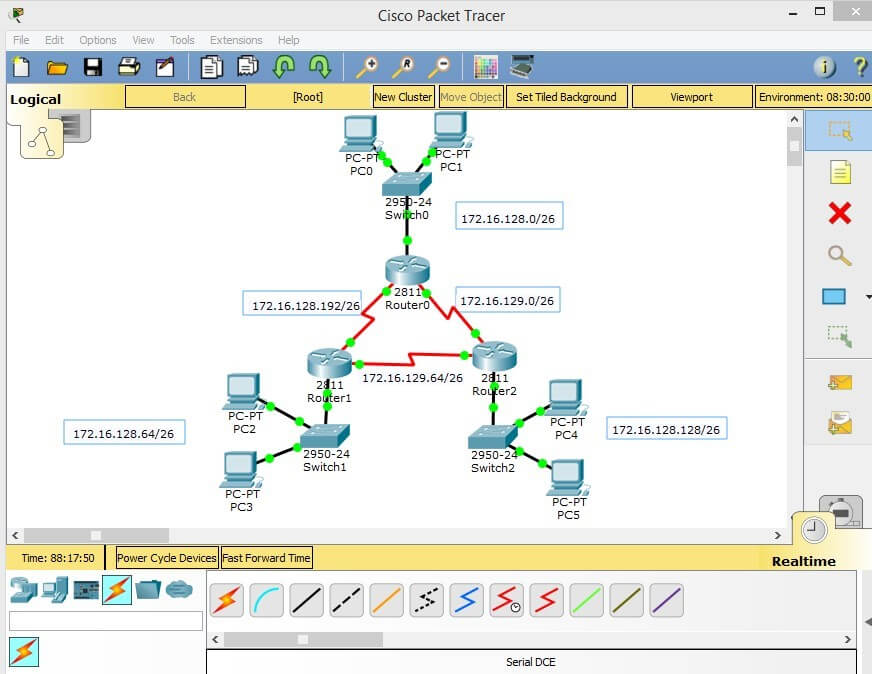
Cyber Security Homework Help
- Ethical Hacking
- Networking Basics homework assignment help
- Inter process Communication/Threads homework assignment help
- Introduction, Framing homework assignment help
- Error Detection homework assignment help
- Flow Control, Reliability homework assignment help
- Wireless - 802.11 homework assignment help
- Wi-Fi Wireless homework assignment help
- DSL homework assignment help
- PACKET SWITCHING (Network Layer) homework assignment help
- Routing - Link State and homework assignment help
- Distance Vector homework assignment help
- ATM homework assignment help
- PROTOCOL homework assignment help
- Network Hardware homework assignment help
- Internet Connection homework assignment help
- TCP Extensions and homework assignment help
- Performance Enhancements homework assignment help
- TCP/IP Networking homework assignment help
- Bridge homework assignment help
- IPv4, IPv6, ICMP, ARP homework assignment help
- IP Routing - CIDR, OSPF homework assignment help
- Proxy Server / Lists homework assignment help
- Multicast homework assignment help
- DNS homework assignment help
- VPN homework assignment help
- CONGESTION CONTROL homework assignment help
- Congestion Avoidance homework assignment help
- peer to peer (P2P) homework assignment help
- Virtual Clock homework assignment help
- Windows Network homework assignment help
- Bluetooth homework assignment help
- Free Practice Test homework assignment help

